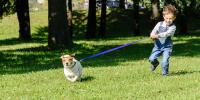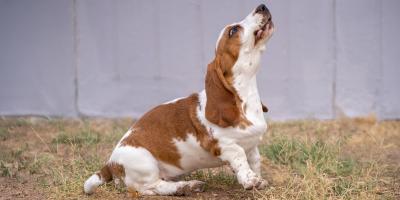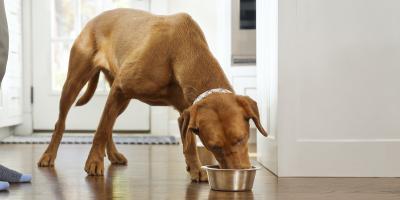Dog Pulling on the Leash? Training a Dog to Walk on a Leash


A strong and healthy relationship with your dog starts with proper training. Find out how you can address behavior issues and improve your relationship with advice from Purina pet behavior experts.
Pulling on the Leash
Your dog needs to learn to properly walk on a leash. At first, he will be excited (so many things to see and to smell!) and he will probably pull on the leash. He needs to learn your expectations.
Proper equipment is the first step, and there are many options for you to try. Some dogs do just fine with a regular buckle collar and a leash, while others respond better to a head collar or a harness, which provide more control.
Training your dog to walk on a leash without pulling takes practice. Your dog needs to learn that if he pulls on the leash at all, you will stop walking right away.
When he stops pulling, reward him with a small treat and a “good dog!” and start walking again. If he pulls, repeat the sequence.
If you are consistent, he will learn that if he wants to move forward he needs to walk on a loose leash. The first times you and your dog practice walking on a loose leash you may not go very far, but it is better to start slow and make solid progress.
Going to the Bathroom Where He Shouldn’t
If your dog is suddenly going where he shouldn’t, first consult your veterinarian. There are a number of behavioral or health-related reasons why this might be happening, such as separation anxiety, a bladder infection, intestinal parasites or age-related cognitive decline.
Even well-trained dogs sometimes have accidents or go where they shouldn’t. Clean the area with a pet odor neutralizer so your dog won’t be tempted to repeat his mistake. Here are some tips to help prevent accidents:
- Avoid making sudden changes in your dog’s diet
- Avoid giving your dog late night snacks
- Make sure he spends enough time outdoors
- Maintain a regular schedule
Excessive Barking
Barking is a natural behavior. However, some dogs bark excessively. This may be due to separation anxiety or loneliness. If your dog suddenly starts barking excessively, talk to your veterinarian to rule out medical causes.
If your dog is barking while you’re away, crate training can provide him with a safe, comforting space that will help calm this behavior.
If he barks while you’re at home, say a firm “no” and reward him with praise when he stops barking. Redirect his behavior by offering him alternatives such as toys or puzzle feeders.
Remember that any action to deter your dog from barking must be taken while he is barking, because correcting him after the fact will only confuse him. Use a strong, firm voice but avoid yelling.
Chewing
Chewing is a normal thing for dogs to do, as long as it isn’t dangerous or destructive. Your dog might chew for many reasons, the main one being that it is fun!
Dogs also chew to release pent-up energy, to relieve stress or when teething (for younger puppies). If your dog is chewing on something that is off-limits, say “no” or “eh” in a low voice. Immediately give him a safe chew toy and praise him for good behavior.
Remember to give your dog safe chew treats or toys instead of household items like old shoes, because this could encourage him to chew on new shoes as well.
Digging
Digging is a normal behavior in dogs and many dogs enjoy digging. In some breeds, the drive to dig is very strong.
Terriers, for example, are known for their digging abilities. “Terrier” is actually French for “burrow.” These breeds were developed to hunt vermin in their dens.
If your dog enjoys digging, consider providing him with a “digging area.” If he confines his digging to this designated area, praise and reward him with attention or a treat; if he is caught digging elsewhere, a firm “no” is usually enough of a deterrent.
Take him to his digging spot and tell him to dig, and praise him if he does this. If you repeat this often, he will likely make the association between his drive to dig and the spot you chose.
During the summer months, some dogs like to dig a hole to lie in and stay cool. If your dog is one of them, try providing a cool place in your yard for him to rest during the day, with a source of shade and fresh drinking water nearby.
Some dogs are escape artists who will dig under a fence to get out of the yard. Ideally, a fence should fit tightly to the ground or be buried a few inches underneath it to prevent a dog from crawling or digging out from under it.
Resource Guarding
It’s not uncommon for dogs to guard things like food, toys or treats. It is believed that this behavior is a holdover from their wild ancestors who had to protect their resources to survive.
However, this may lead to unfortunate incidents in a household. Through practice sharing toys or treats, puppies can be trained to “share” their resources with humans.
When your puppy is playing with a toy, show him a small treat. He will probably drop the toy and go for the treat. When he does, take the toy away from him.
When he is done with the treat, ask him to sit and give him back his toy. Repeat several times, and over a long period of time, he will learn that sharing is fun.
If your dog is an adult and tends to guard his food or toys, ask for help from a dog behaviorist. It is harder to teach an adult dog to share, and a custom behavior modification program is probably necessary.
If your resource-guarding dog lives with other dogs, separating him from the other dogs at feeding time or when toys are present will be necessary. Also, make sure that the humans in the house, and more specifically children, are safe and not in harm’s way.
When Your Dog is Behaving Badly, Understanding is Key
We hope this guide helps you understand and improve your dog’s behavior, and also your relationship with your dog. For more tips from Purina’s experts, visit our Pet Expertise page.
Related articles

Reward Yourself with myPurina
Earn and redeem rewards for Purina products with the myPurina app.






